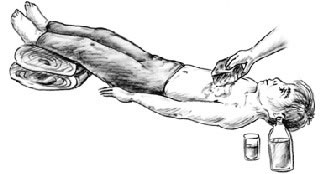Photos

FIRST AID Advice - Heat Exhaustion
- Move the person to a cool shady area. If possible, move them into an air-conditioned place.
- Have the person lie down. Elevate the feet.
- Undress the person (except for underwear), so the body surface can give off heat.
- Sponge the entire body surface continuously with cool water. Fan the person to increase evaporation.
- Give as much cold water or sports drink (e.g., Gatorade, Powerade) as the person can tolerate. An adult or teen with heat exhaustion should drink 2-3 cups (480-720 mL) of liquids right away to replace what was lost. Then the adult or teen should drink approximately 1 cup (240 mL) every 15 minutes for the next 1-2 hours.
Source: Self Care Decisions, LLC
Used with Permission from Schmitt Pediatric Guidelines LLC.